Report: Business Environment Analysis of Tesco PLC (Coursework)
VerifiedAdded on 2020/06/05
|14
|4432
|42
Report
AI Summary
This report provides a comprehensive analysis of Tesco PLC's business environment. It begins with an introduction to the concept of the business environment and its impact on a company's performance. The report then delves into Tesco PLC, detailing its functions and organizational structure, including its functional areas and an organizational chart. The report then applies the PESTLE analysis to evaluate the external factors affecting Tesco, such as political, economic, social, technological, legal, and environmental factors. Following this, the report examines Tesco's internal and external environment through SWOT analysis, identifying its strengths, weaknesses, opportunities, and threats, and discusses their impact on the decision-making process. The report concludes by summarizing the key findings and insights into Tesco's strategic position within the retail industry.
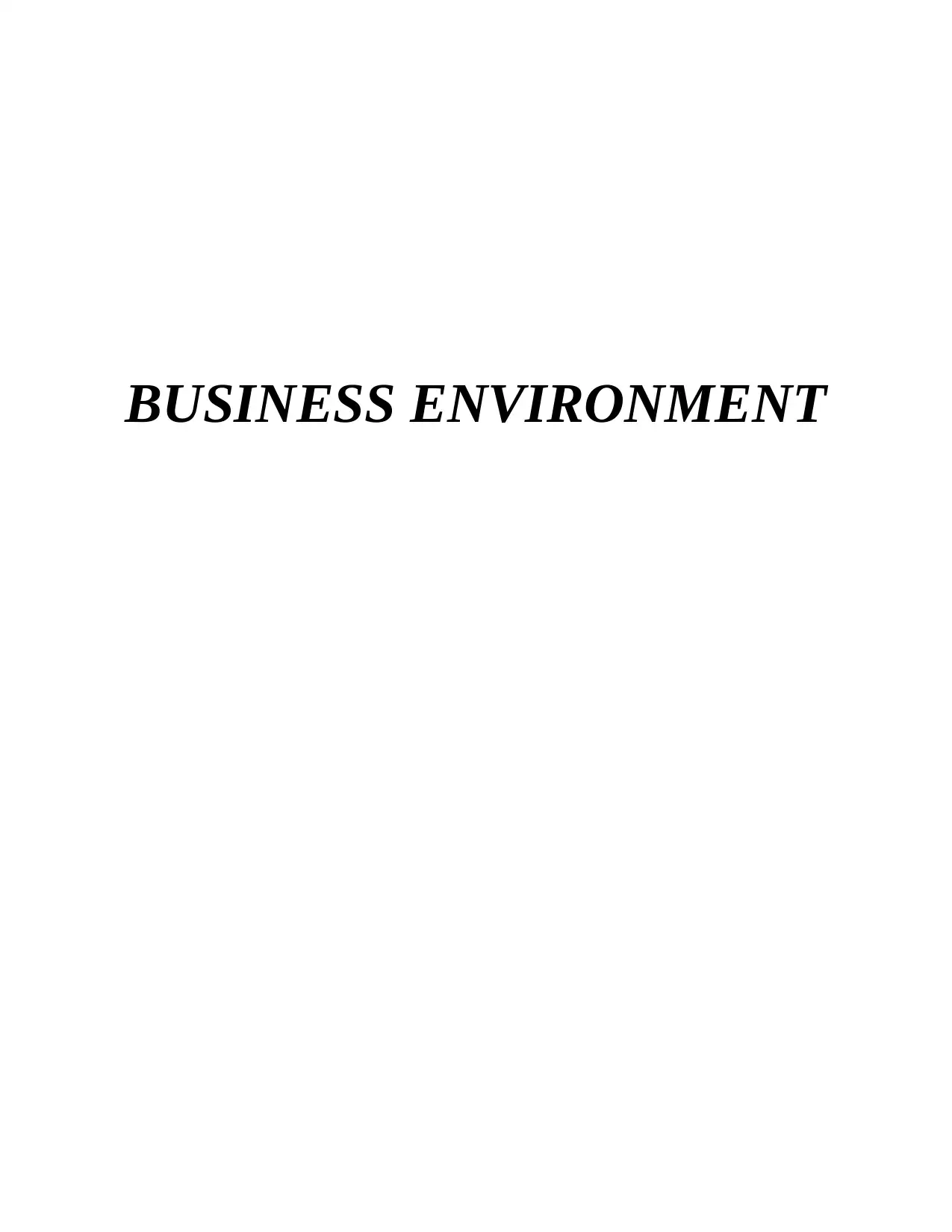
BUSINESS ENVIRONMENT
Paraphrase This Document
Need a fresh take? Get an instant paraphrase of this document with our AI Paraphraser
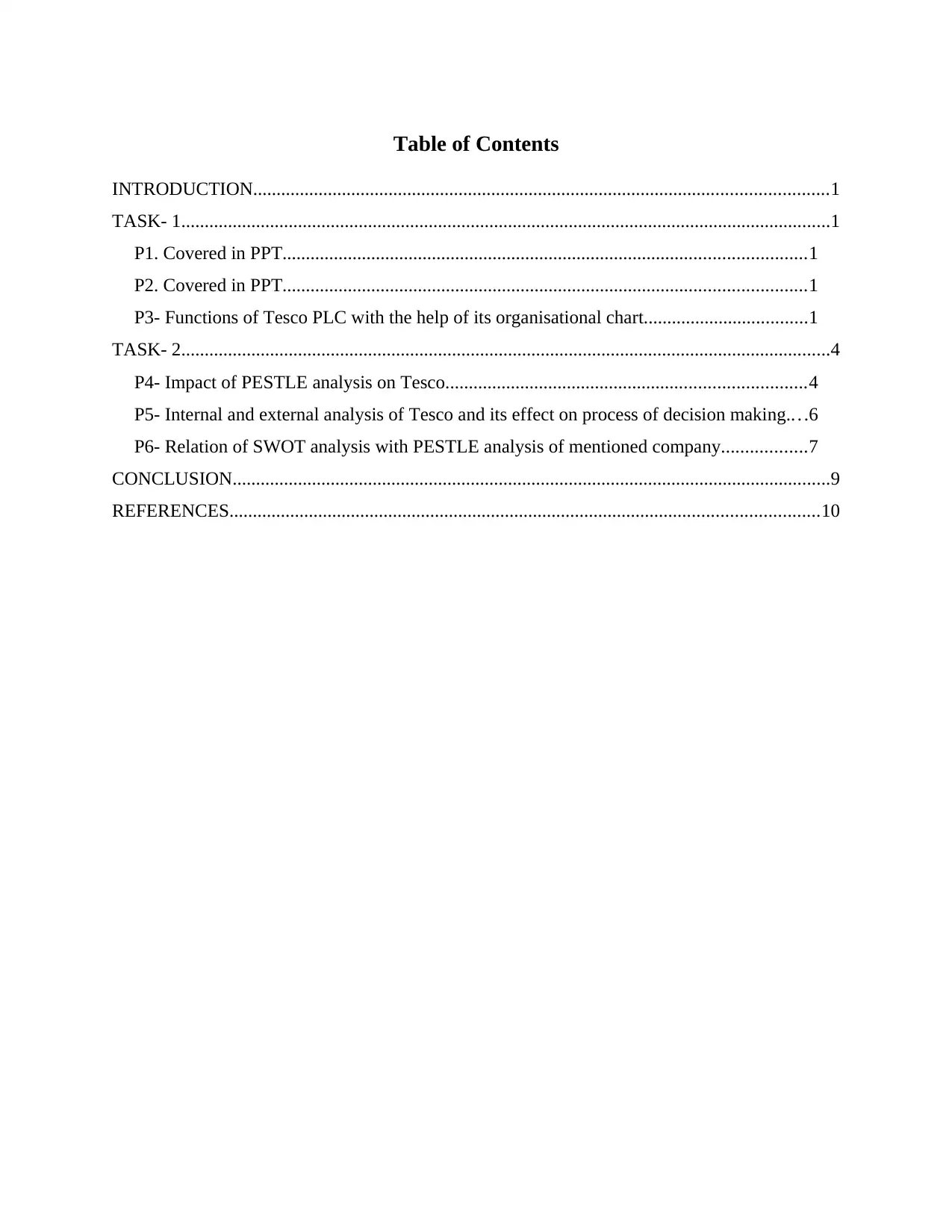
Table of Contents
INTRODUCTION...........................................................................................................................1
TASK- 1...........................................................................................................................................1
P1. Covered in PPT................................................................................................................1
P2. Covered in PPT................................................................................................................1
P3- Functions of Tesco PLC with the help of its organisational chart...................................1
TASK- 2...........................................................................................................................................4
P4- Impact of PESTLE analysis on Tesco.............................................................................4
P5- Internal and external analysis of Tesco and its effect on process of decision making... .6
P6- Relation of SWOT analysis with PESTLE analysis of mentioned company..................7
CONCLUSION................................................................................................................................9
REFERENCES..............................................................................................................................10
INTRODUCTION...........................................................................................................................1
TASK- 1...........................................................................................................................................1
P1. Covered in PPT................................................................................................................1
P2. Covered in PPT................................................................................................................1
P3- Functions of Tesco PLC with the help of its organisational chart...................................1
TASK- 2...........................................................................................................................................4
P4- Impact of PESTLE analysis on Tesco.............................................................................4
P5- Internal and external analysis of Tesco and its effect on process of decision making... .6
P6- Relation of SWOT analysis with PESTLE analysis of mentioned company..................7
CONCLUSION................................................................................................................................9
REFERENCES..............................................................................................................................10

⊘ This is a preview!⊘
Do you want full access?
Subscribe today to unlock all pages.

Trusted by 1+ million students worldwide
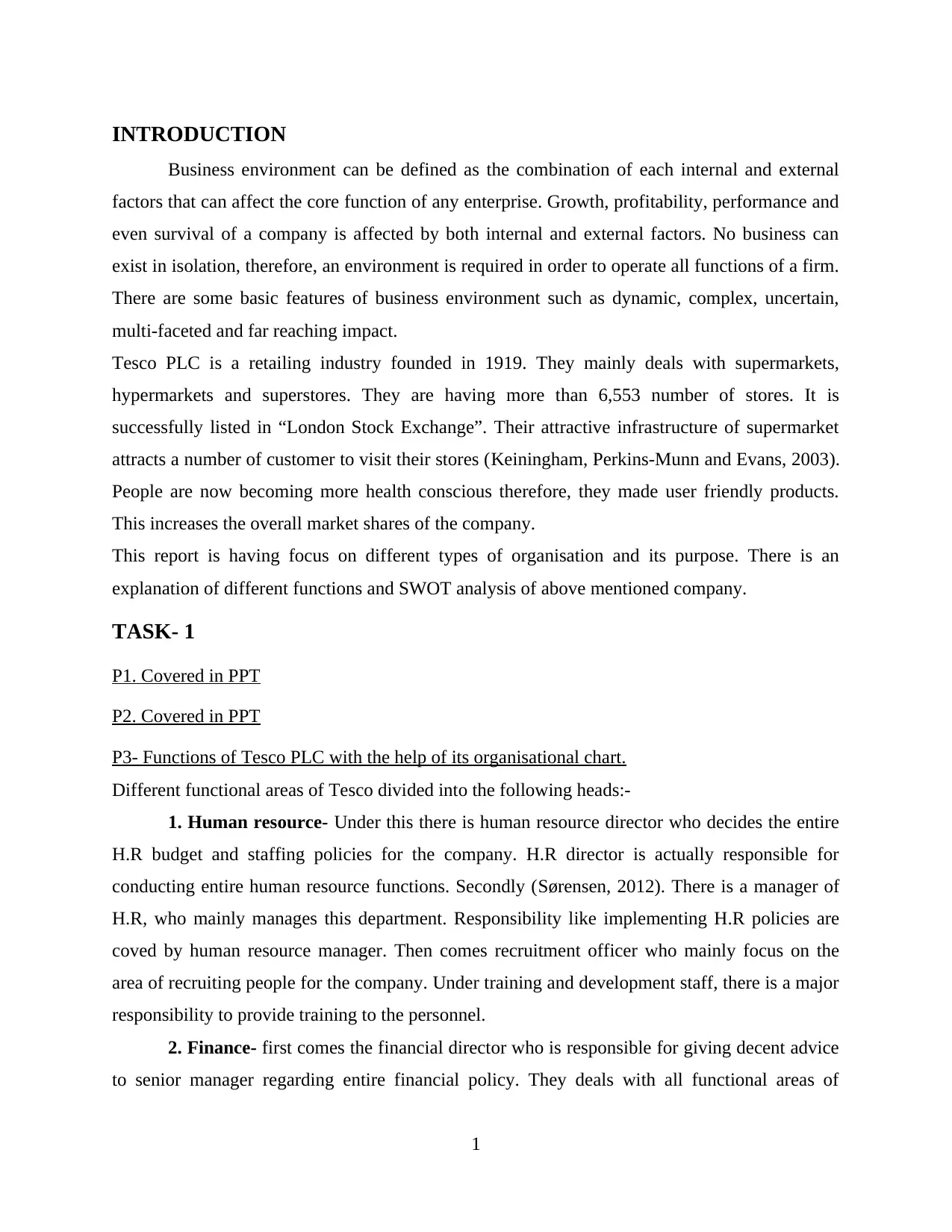
INTRODUCTION
Business environment can be defined as the combination of each internal and external
factors that can affect the core function of any enterprise. Growth, profitability, performance and
even survival of a company is affected by both internal and external factors. No business can
exist in isolation, therefore, an environment is required in order to operate all functions of a firm.
There are some basic features of business environment such as dynamic, complex, uncertain,
multi-faceted and far reaching impact.
Tesco PLC is a retailing industry founded in 1919. They mainly deals with supermarkets,
hypermarkets and superstores. They are having more than 6,553 number of stores. It is
successfully listed in “London Stock Exchange”. Their attractive infrastructure of supermarket
attracts a number of customer to visit their stores (Keiningham, Perkins-Munn and Evans, 2003).
People are now becoming more health conscious therefore, they made user friendly products.
This increases the overall market shares of the company.
This report is having focus on different types of organisation and its purpose. There is an
explanation of different functions and SWOT analysis of above mentioned company.
TASK- 1
P1. Covered in PPT
P2. Covered in PPT
P3- Functions of Tesco PLC with the help of its organisational chart.
Different functional areas of Tesco divided into the following heads:-
1. Human resource- Under this there is human resource director who decides the entire
H.R budget and staffing policies for the company. H.R director is actually responsible for
conducting entire human resource functions. Secondly (Sørensen, 2012). There is a manager of
H.R, who mainly manages this department. Responsibility like implementing H.R policies are
coved by human resource manager. Then comes recruitment officer who mainly focus on the
area of recruiting people for the company. Under training and development staff, there is a major
responsibility to provide training to the personnel.
2. Finance- first comes the financial director who is responsible for giving decent advice
to senior manager regarding entire financial policy. They deals with all functional areas of
1
Business environment can be defined as the combination of each internal and external
factors that can affect the core function of any enterprise. Growth, profitability, performance and
even survival of a company is affected by both internal and external factors. No business can
exist in isolation, therefore, an environment is required in order to operate all functions of a firm.
There are some basic features of business environment such as dynamic, complex, uncertain,
multi-faceted and far reaching impact.
Tesco PLC is a retailing industry founded in 1919. They mainly deals with supermarkets,
hypermarkets and superstores. They are having more than 6,553 number of stores. It is
successfully listed in “London Stock Exchange”. Their attractive infrastructure of supermarket
attracts a number of customer to visit their stores (Keiningham, Perkins-Munn and Evans, 2003).
People are now becoming more health conscious therefore, they made user friendly products.
This increases the overall market shares of the company.
This report is having focus on different types of organisation and its purpose. There is an
explanation of different functions and SWOT analysis of above mentioned company.
TASK- 1
P1. Covered in PPT
P2. Covered in PPT
P3- Functions of Tesco PLC with the help of its organisational chart.
Different functional areas of Tesco divided into the following heads:-
1. Human resource- Under this there is human resource director who decides the entire
H.R budget and staffing policies for the company. H.R director is actually responsible for
conducting entire human resource functions. Secondly (Sørensen, 2012). There is a manager of
H.R, who mainly manages this department. Responsibility like implementing H.R policies are
coved by human resource manager. Then comes recruitment officer who mainly focus on the
area of recruiting people for the company. Under training and development staff, there is a major
responsibility to provide training to the personnel.
2. Finance- first comes the financial director who is responsible for giving decent advice
to senior manager regarding entire financial policy. They deals with all functional areas of
1
Paraphrase This Document
Need a fresh take? Get an instant paraphrase of this document with our AI Paraphraser
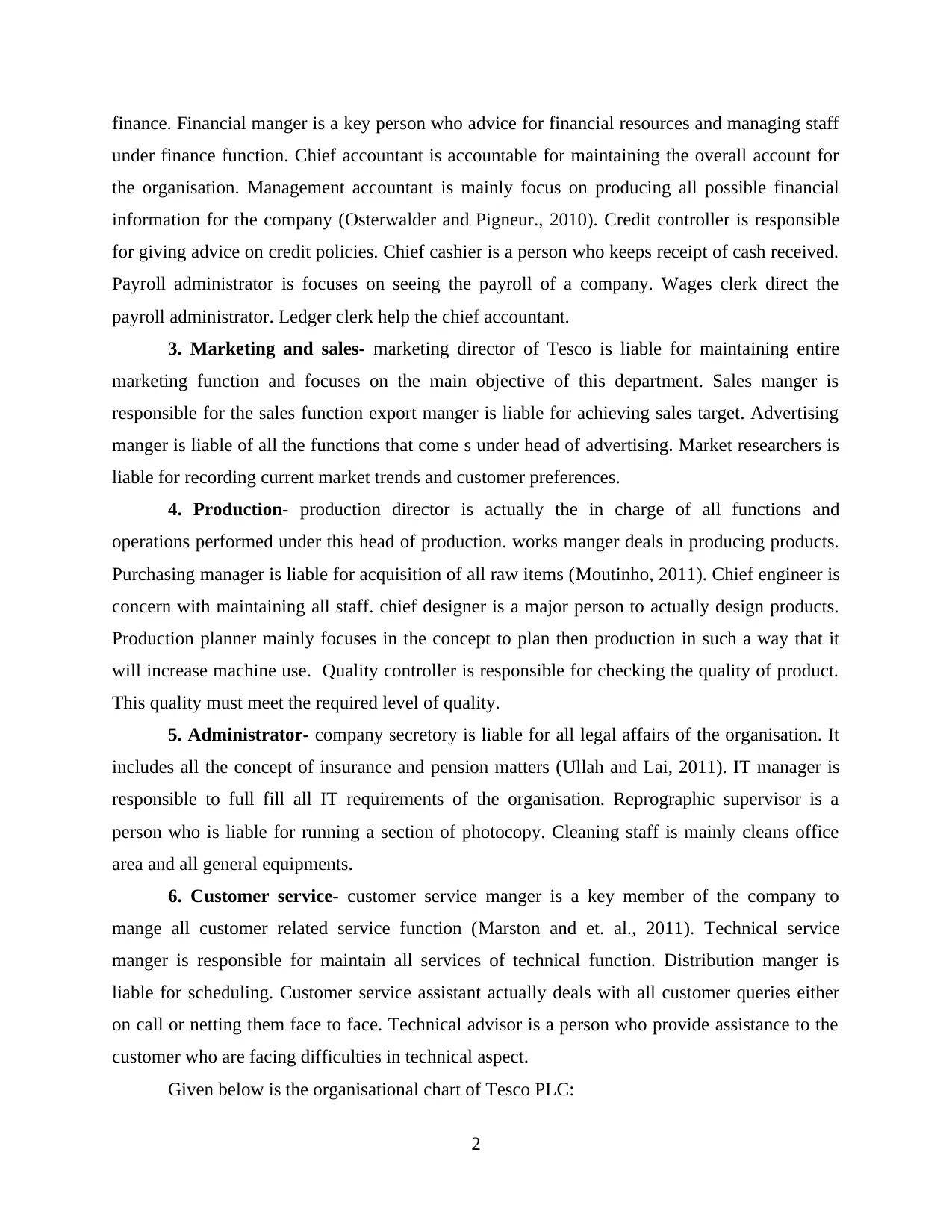
finance. Financial manger is a key person who advice for financial resources and managing staff
under finance function. Chief accountant is accountable for maintaining the overall account for
the organisation. Management accountant is mainly focus on producing all possible financial
information for the company (Osterwalder and Pigneur., 2010). Credit controller is responsible
for giving advice on credit policies. Chief cashier is a person who keeps receipt of cash received.
Payroll administrator is focuses on seeing the payroll of a company. Wages clerk direct the
payroll administrator. Ledger clerk help the chief accountant.
3. Marketing and sales- marketing director of Tesco is liable for maintaining entire
marketing function and focuses on the main objective of this department. Sales manger is
responsible for the sales function export manger is liable for achieving sales target. Advertising
manger is liable of all the functions that come s under head of advertising. Market researchers is
liable for recording current market trends and customer preferences.
4. Production- production director is actually the in charge of all functions and
operations performed under this head of production. works manger deals in producing products.
Purchasing manager is liable for acquisition of all raw items (Moutinho, 2011). Chief engineer is
concern with maintaining all staff. chief designer is a major person to actually design products.
Production planner mainly focuses in the concept to plan then production in such a way that it
will increase machine use. Quality controller is responsible for checking the quality of product.
This quality must meet the required level of quality.
5. Administrator- company secretory is liable for all legal affairs of the organisation. It
includes all the concept of insurance and pension matters (Ullah and Lai, 2011). IT manager is
responsible to full fill all IT requirements of the organisation. Reprographic supervisor is a
person who is liable for running a section of photocopy. Cleaning staff is mainly cleans office
area and all general equipments.
6. Customer service- customer service manger is a key member of the company to
mange all customer related service function (Marston and et. al., 2011). Technical service
manger is responsible for maintain all services of technical function. Distribution manger is
liable for scheduling. Customer service assistant actually deals with all customer queries either
on call or netting them face to face. Technical advisor is a person who provide assistance to the
customer who are facing difficulties in technical aspect.
Given below is the organisational chart of Tesco PLC:
2
under finance function. Chief accountant is accountable for maintaining the overall account for
the organisation. Management accountant is mainly focus on producing all possible financial
information for the company (Osterwalder and Pigneur., 2010). Credit controller is responsible
for giving advice on credit policies. Chief cashier is a person who keeps receipt of cash received.
Payroll administrator is focuses on seeing the payroll of a company. Wages clerk direct the
payroll administrator. Ledger clerk help the chief accountant.
3. Marketing and sales- marketing director of Tesco is liable for maintaining entire
marketing function and focuses on the main objective of this department. Sales manger is
responsible for the sales function export manger is liable for achieving sales target. Advertising
manger is liable of all the functions that come s under head of advertising. Market researchers is
liable for recording current market trends and customer preferences.
4. Production- production director is actually the in charge of all functions and
operations performed under this head of production. works manger deals in producing products.
Purchasing manager is liable for acquisition of all raw items (Moutinho, 2011). Chief engineer is
concern with maintaining all staff. chief designer is a major person to actually design products.
Production planner mainly focuses in the concept to plan then production in such a way that it
will increase machine use. Quality controller is responsible for checking the quality of product.
This quality must meet the required level of quality.
5. Administrator- company secretory is liable for all legal affairs of the organisation. It
includes all the concept of insurance and pension matters (Ullah and Lai, 2011). IT manager is
responsible to full fill all IT requirements of the organisation. Reprographic supervisor is a
person who is liable for running a section of photocopy. Cleaning staff is mainly cleans office
area and all general equipments.
6. Customer service- customer service manger is a key member of the company to
mange all customer related service function (Marston and et. al., 2011). Technical service
manger is responsible for maintain all services of technical function. Distribution manger is
liable for scheduling. Customer service assistant actually deals with all customer queries either
on call or netting them face to face. Technical advisor is a person who provide assistance to the
customer who are facing difficulties in technical aspect.
Given below is the organisational chart of Tesco PLC:
2
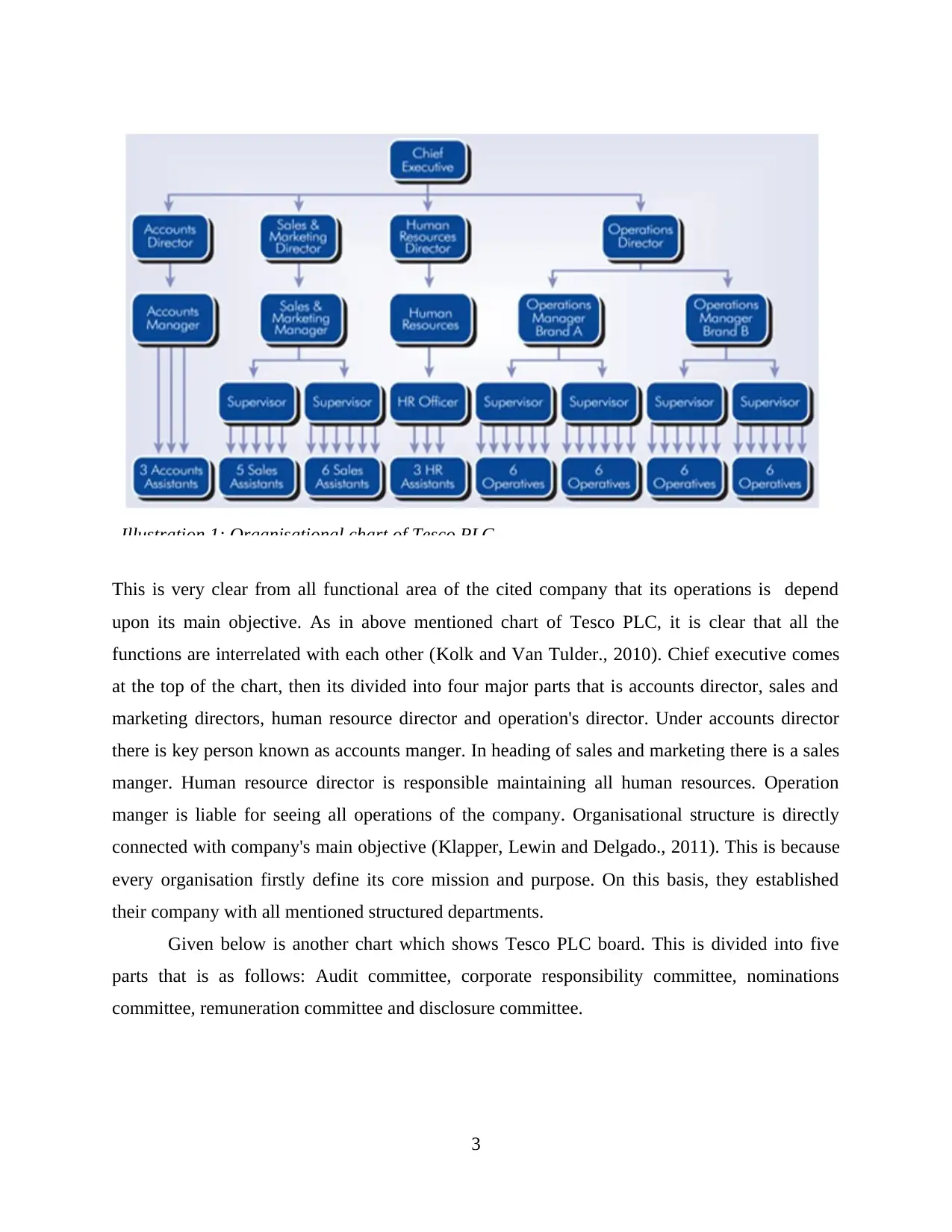
This is very clear from all functional area of the cited company that its operations is depend
upon its main objective. As in above mentioned chart of Tesco PLC, it is clear that all the
functions are interrelated with each other (Kolk and Van Tulder., 2010). Chief executive comes
at the top of the chart, then its divided into four major parts that is accounts director, sales and
marketing directors, human resource director and operation's director. Under accounts director
there is key person known as accounts manger. In heading of sales and marketing there is a sales
manger. Human resource director is responsible maintaining all human resources. Operation
manger is liable for seeing all operations of the company. Organisational structure is directly
connected with company's main objective (Klapper, Lewin and Delgado., 2011). This is because
every organisation firstly define its core mission and purpose. On this basis, they established
their company with all mentioned structured departments.
Given below is another chart which shows Tesco PLC board. This is divided into five
parts that is as follows: Audit committee, corporate responsibility committee, nominations
committee, remuneration committee and disclosure committee.
3
Illustration 1: Organisational chart of Tesco PLC
upon its main objective. As in above mentioned chart of Tesco PLC, it is clear that all the
functions are interrelated with each other (Kolk and Van Tulder., 2010). Chief executive comes
at the top of the chart, then its divided into four major parts that is accounts director, sales and
marketing directors, human resource director and operation's director. Under accounts director
there is key person known as accounts manger. In heading of sales and marketing there is a sales
manger. Human resource director is responsible maintaining all human resources. Operation
manger is liable for seeing all operations of the company. Organisational structure is directly
connected with company's main objective (Klapper, Lewin and Delgado., 2011). This is because
every organisation firstly define its core mission and purpose. On this basis, they established
their company with all mentioned structured departments.
Given below is another chart which shows Tesco PLC board. This is divided into five
parts that is as follows: Audit committee, corporate responsibility committee, nominations
committee, remuneration committee and disclosure committee.
3
Illustration 1: Organisational chart of Tesco PLC
⊘ This is a preview!⊘
Do you want full access?
Subscribe today to unlock all pages.

Trusted by 1+ million students worldwide
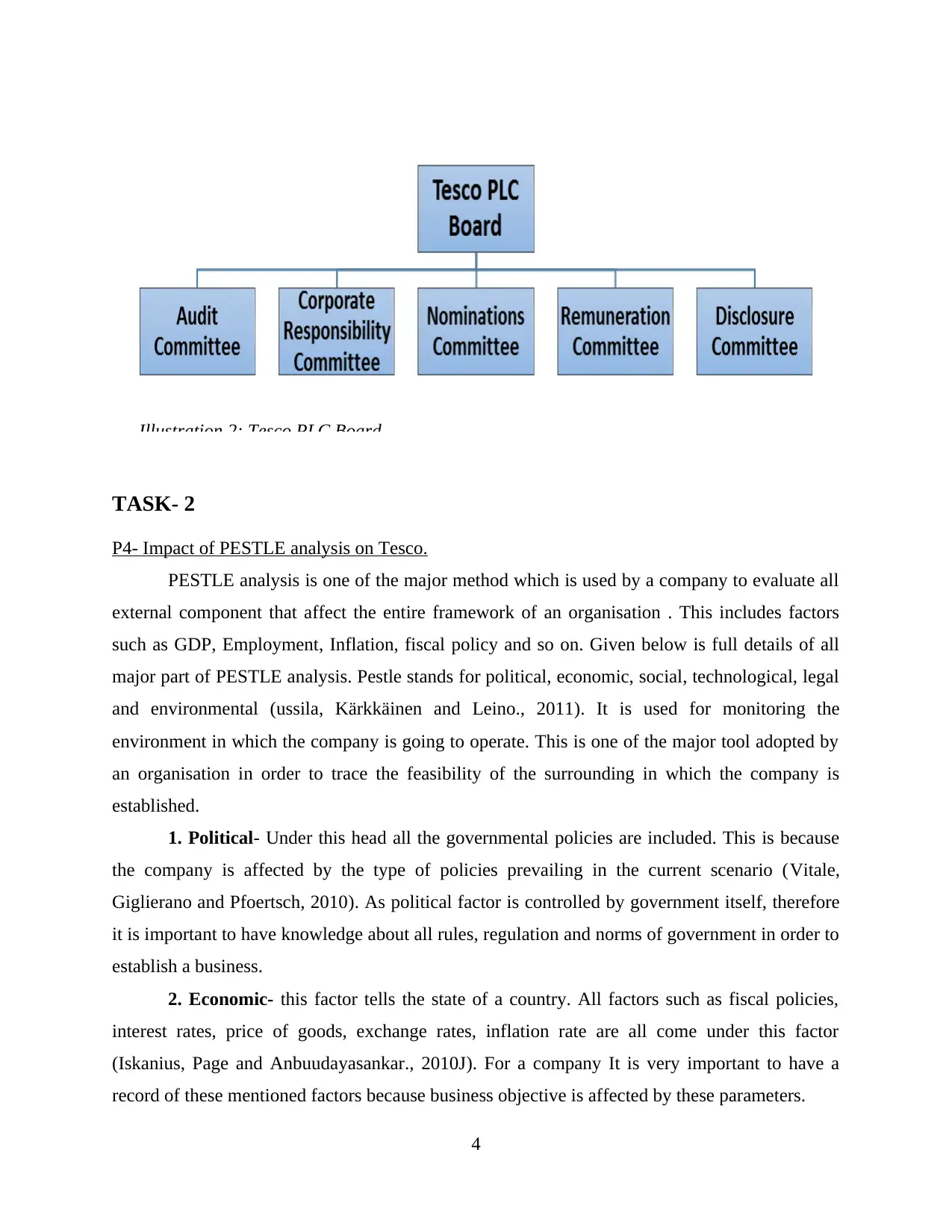
TASK- 2
P4- Impact of PESTLE analysis on Tesco.
PESTLE analysis is one of the major method which is used by a company to evaluate all
external component that affect the entire framework of an organisation . This includes factors
such as GDP, Employment, Inflation, fiscal policy and so on. Given below is full details of all
major part of PESTLE analysis. Pestle stands for political, economic, social, technological, legal
and environmental (ussila, Kärkkäinen and Leino., 2011). It is used for monitoring the
environment in which the company is going to operate. This is one of the major tool adopted by
an organisation in order to trace the feasibility of the surrounding in which the company is
established.
1. Political- Under this head all the governmental policies are included. This is because
the company is affected by the type of policies prevailing in the current scenario (Vitale,
Giglierano and Pfoertsch, 2010). As political factor is controlled by government itself, therefore
it is important to have knowledge about all rules, regulation and norms of government in order to
establish a business.
2. Economic- this factor tells the state of a country. All factors such as fiscal policies,
interest rates, price of goods, exchange rates, inflation rate are all come under this factor
(Iskanius, Page and Anbuudayasankar., 2010J). For a company It is very important to have a
record of these mentioned factors because business objective is affected by these parameters.
4
Illustration 2: Tesco PLC Board.
P4- Impact of PESTLE analysis on Tesco.
PESTLE analysis is one of the major method which is used by a company to evaluate all
external component that affect the entire framework of an organisation . This includes factors
such as GDP, Employment, Inflation, fiscal policy and so on. Given below is full details of all
major part of PESTLE analysis. Pestle stands for political, economic, social, technological, legal
and environmental (ussila, Kärkkäinen and Leino., 2011). It is used for monitoring the
environment in which the company is going to operate. This is one of the major tool adopted by
an organisation in order to trace the feasibility of the surrounding in which the company is
established.
1. Political- Under this head all the governmental policies are included. This is because
the company is affected by the type of policies prevailing in the current scenario (Vitale,
Giglierano and Pfoertsch, 2010). As political factor is controlled by government itself, therefore
it is important to have knowledge about all rules, regulation and norms of government in order to
establish a business.
2. Economic- this factor tells the state of a country. All factors such as fiscal policies,
interest rates, price of goods, exchange rates, inflation rate are all come under this factor
(Iskanius, Page and Anbuudayasankar., 2010J). For a company It is very important to have a
record of these mentioned factors because business objective is affected by these parameters.
4
Illustration 2: Tesco PLC Board.
Paraphrase This Document
Need a fresh take? Get an instant paraphrase of this document with our AI Paraphraser
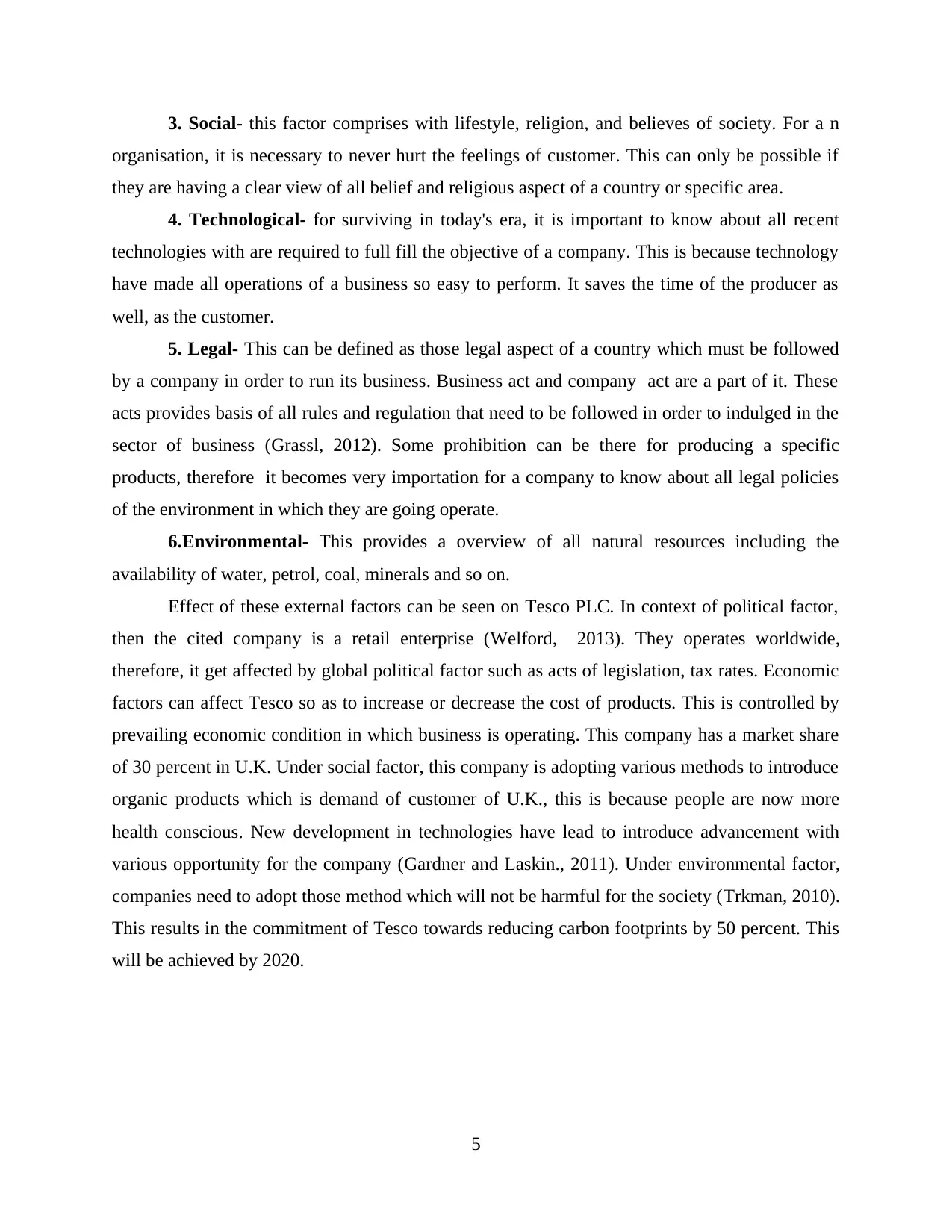
3. Social- this factor comprises with lifestyle, religion, and believes of society. For a n
organisation, it is necessary to never hurt the feelings of customer. This can only be possible if
they are having a clear view of all belief and religious aspect of a country or specific area.
4. Technological- for surviving in today's era, it is important to know about all recent
technologies with are required to full fill the objective of a company. This is because technology
have made all operations of a business so easy to perform. It saves the time of the producer as
well, as the customer.
5. Legal- This can be defined as those legal aspect of a country which must be followed
by a company in order to run its business. Business act and company act are a part of it. These
acts provides basis of all rules and regulation that need to be followed in order to indulged in the
sector of business (Grassl, 2012). Some prohibition can be there for producing a specific
products, therefore it becomes very importation for a company to know about all legal policies
of the environment in which they are going operate.
6.Environmental- This provides a overview of all natural resources including the
availability of water, petrol, coal, minerals and so on.
Effect of these external factors can be seen on Tesco PLC. In context of political factor,
then the cited company is a retail enterprise (Welford, 2013). They operates worldwide,
therefore, it get affected by global political factor such as acts of legislation, tax rates. Economic
factors can affect Tesco so as to increase or decrease the cost of products. This is controlled by
prevailing economic condition in which business is operating. This company has a market share
of 30 percent in U.K. Under social factor, this company is adopting various methods to introduce
organic products which is demand of customer of U.K., this is because people are now more
health conscious. New development in technologies have lead to introduce advancement with
various opportunity for the company (Gardner and Laskin., 2011). Under environmental factor,
companies need to adopt those method which will not be harmful for the society (Trkman, 2010).
This results in the commitment of Tesco towards reducing carbon footprints by 50 percent. This
will be achieved by 2020.
5
organisation, it is necessary to never hurt the feelings of customer. This can only be possible if
they are having a clear view of all belief and religious aspect of a country or specific area.
4. Technological- for surviving in today's era, it is important to know about all recent
technologies with are required to full fill the objective of a company. This is because technology
have made all operations of a business so easy to perform. It saves the time of the producer as
well, as the customer.
5. Legal- This can be defined as those legal aspect of a country which must be followed
by a company in order to run its business. Business act and company act are a part of it. These
acts provides basis of all rules and regulation that need to be followed in order to indulged in the
sector of business (Grassl, 2012). Some prohibition can be there for producing a specific
products, therefore it becomes very importation for a company to know about all legal policies
of the environment in which they are going operate.
6.Environmental- This provides a overview of all natural resources including the
availability of water, petrol, coal, minerals and so on.
Effect of these external factors can be seen on Tesco PLC. In context of political factor,
then the cited company is a retail enterprise (Welford, 2013). They operates worldwide,
therefore, it get affected by global political factor such as acts of legislation, tax rates. Economic
factors can affect Tesco so as to increase or decrease the cost of products. This is controlled by
prevailing economic condition in which business is operating. This company has a market share
of 30 percent in U.K. Under social factor, this company is adopting various methods to introduce
organic products which is demand of customer of U.K., this is because people are now more
health conscious. New development in technologies have lead to introduce advancement with
various opportunity for the company (Gardner and Laskin., 2011). Under environmental factor,
companies need to adopt those method which will not be harmful for the society (Trkman, 2010).
This results in the commitment of Tesco towards reducing carbon footprints by 50 percent. This
will be achieved by 2020.
5
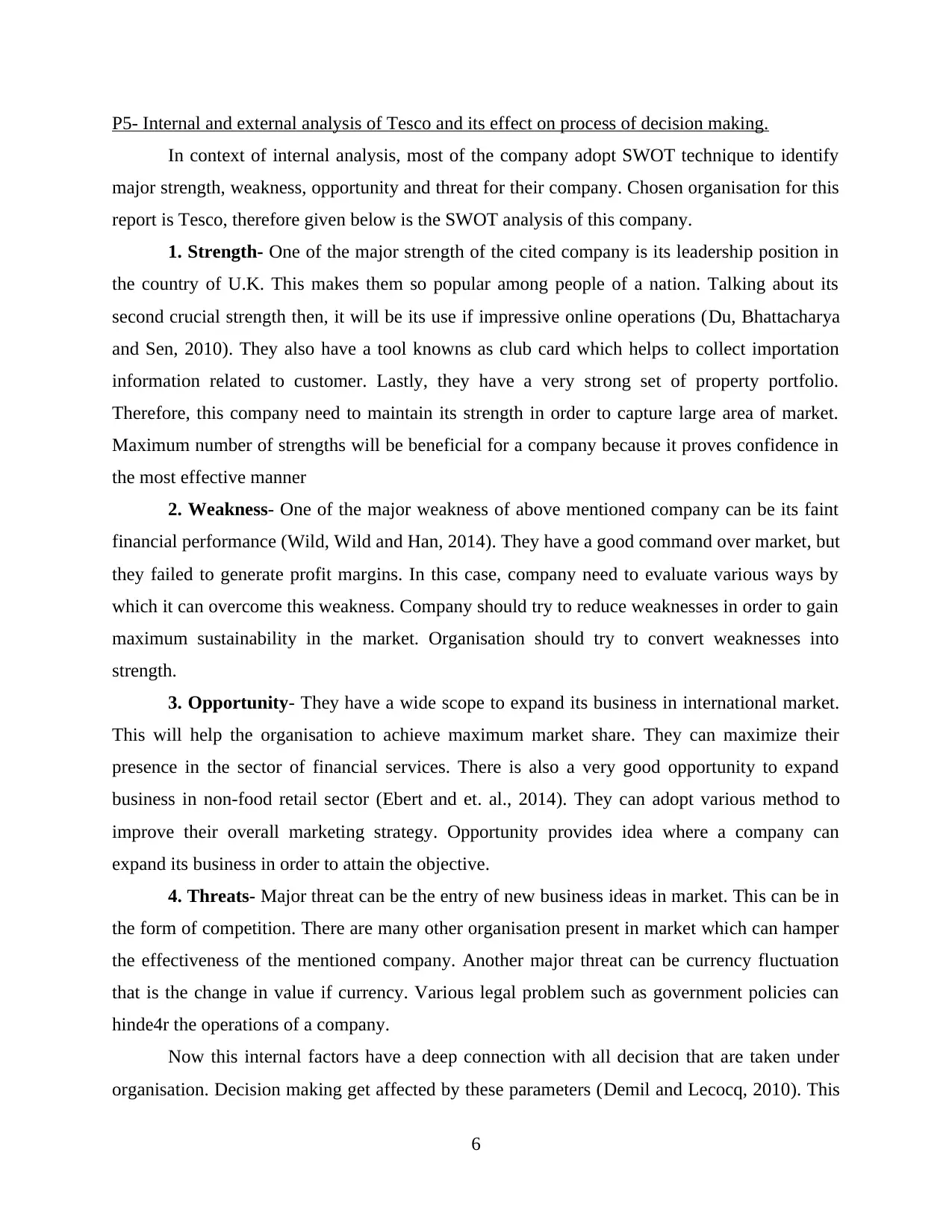
P5- Internal and external analysis of Tesco and its effect on process of decision making.
In context of internal analysis, most of the company adopt SWOT technique to identify
major strength, weakness, opportunity and threat for their company. Chosen organisation for this
report is Tesco, therefore given below is the SWOT analysis of this company.
1. Strength- One of the major strength of the cited company is its leadership position in
the country of U.K. This makes them so popular among people of a nation. Talking about its
second crucial strength then, it will be its use if impressive online operations (Du, Bhattacharya
and Sen, 2010). They also have a tool knowns as club card which helps to collect importation
information related to customer. Lastly, they have a very strong set of property portfolio.
Therefore, this company need to maintain its strength in order to capture large area of market.
Maximum number of strengths will be beneficial for a company because it proves confidence in
the most effective manner
2. Weakness- One of the major weakness of above mentioned company can be its faint
financial performance (Wild, Wild and Han, 2014). They have a good command over market, but
they failed to generate profit margins. In this case, company need to evaluate various ways by
which it can overcome this weakness. Company should try to reduce weaknesses in order to gain
maximum sustainability in the market. Organisation should try to convert weaknesses into
strength.
3. Opportunity- They have a wide scope to expand its business in international market.
This will help the organisation to achieve maximum market share. They can maximize their
presence in the sector of financial services. There is also a very good opportunity to expand
business in non-food retail sector (Ebert and et. al., 2014). They can adopt various method to
improve their overall marketing strategy. Opportunity provides idea where a company can
expand its business in order to attain the objective.
4. Threats- Major threat can be the entry of new business ideas in market. This can be in
the form of competition. There are many other organisation present in market which can hamper
the effectiveness of the mentioned company. Another major threat can be currency fluctuation
that is the change in value if currency. Various legal problem such as government policies can
hinde4r the operations of a company.
Now this internal factors have a deep connection with all decision that are taken under
organisation. Decision making get affected by these parameters (Demil and Lecocq, 2010). This
6
In context of internal analysis, most of the company adopt SWOT technique to identify
major strength, weakness, opportunity and threat for their company. Chosen organisation for this
report is Tesco, therefore given below is the SWOT analysis of this company.
1. Strength- One of the major strength of the cited company is its leadership position in
the country of U.K. This makes them so popular among people of a nation. Talking about its
second crucial strength then, it will be its use if impressive online operations (Du, Bhattacharya
and Sen, 2010). They also have a tool knowns as club card which helps to collect importation
information related to customer. Lastly, they have a very strong set of property portfolio.
Therefore, this company need to maintain its strength in order to capture large area of market.
Maximum number of strengths will be beneficial for a company because it proves confidence in
the most effective manner
2. Weakness- One of the major weakness of above mentioned company can be its faint
financial performance (Wild, Wild and Han, 2014). They have a good command over market, but
they failed to generate profit margins. In this case, company need to evaluate various ways by
which it can overcome this weakness. Company should try to reduce weaknesses in order to gain
maximum sustainability in the market. Organisation should try to convert weaknesses into
strength.
3. Opportunity- They have a wide scope to expand its business in international market.
This will help the organisation to achieve maximum market share. They can maximize their
presence in the sector of financial services. There is also a very good opportunity to expand
business in non-food retail sector (Ebert and et. al., 2014). They can adopt various method to
improve their overall marketing strategy. Opportunity provides idea where a company can
expand its business in order to attain the objective.
4. Threats- Major threat can be the entry of new business ideas in market. This can be in
the form of competition. There are many other organisation present in market which can hamper
the effectiveness of the mentioned company. Another major threat can be currency fluctuation
that is the change in value if currency. Various legal problem such as government policies can
hinde4r the operations of a company.
Now this internal factors have a deep connection with all decision that are taken under
organisation. Decision making get affected by these parameters (Demil and Lecocq, 2010). This
6
⊘ This is a preview!⊘
Do you want full access?
Subscribe today to unlock all pages.

Trusted by 1+ million students worldwide
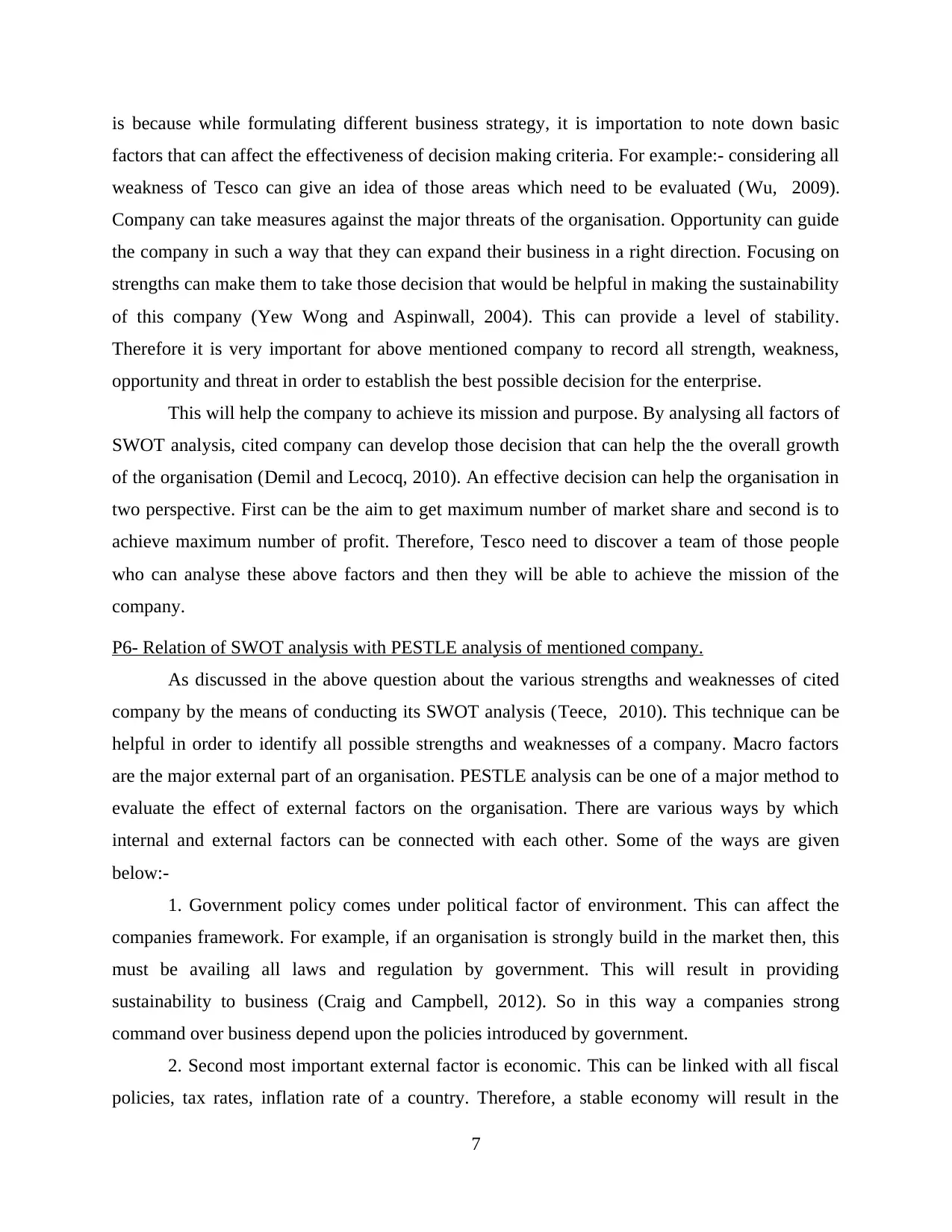
is because while formulating different business strategy, it is importation to note down basic
factors that can affect the effectiveness of decision making criteria. For example:- considering all
weakness of Tesco can give an idea of those areas which need to be evaluated (Wu, 2009).
Company can take measures against the major threats of the organisation. Opportunity can guide
the company in such a way that they can expand their business in a right direction. Focusing on
strengths can make them to take those decision that would be helpful in making the sustainability
of this company (Yew Wong and Aspinwall, 2004). This can provide a level of stability.
Therefore it is very important for above mentioned company to record all strength, weakness,
opportunity and threat in order to establish the best possible decision for the enterprise.
This will help the company to achieve its mission and purpose. By analysing all factors of
SWOT analysis, cited company can develop those decision that can help the the overall growth
of the organisation (Demil and Lecocq, 2010). An effective decision can help the organisation in
two perspective. First can be the aim to get maximum number of market share and second is to
achieve maximum number of profit. Therefore, Tesco need to discover a team of those people
who can analyse these above factors and then they will be able to achieve the mission of the
company.
P6- Relation of SWOT analysis with PESTLE analysis of mentioned company.
As discussed in the above question about the various strengths and weaknesses of cited
company by the means of conducting its SWOT analysis (Teece, 2010). This technique can be
helpful in order to identify all possible strengths and weaknesses of a company. Macro factors
are the major external part of an organisation. PESTLE analysis can be one of a major method to
evaluate the effect of external factors on the organisation. There are various ways by which
internal and external factors can be connected with each other. Some of the ways are given
below:-
1. Government policy comes under political factor of environment. This can affect the
companies framework. For example, if an organisation is strongly build in the market then, this
must be availing all laws and regulation by government. This will result in providing
sustainability to business (Craig and Campbell, 2012). So in this way a companies strong
command over business depend upon the policies introduced by government.
2. Second most important external factor is economic. This can be linked with all fiscal
policies, tax rates, inflation rate of a country. Therefore, a stable economy will result in the
7
factors that can affect the effectiveness of decision making criteria. For example:- considering all
weakness of Tesco can give an idea of those areas which need to be evaluated (Wu, 2009).
Company can take measures against the major threats of the organisation. Opportunity can guide
the company in such a way that they can expand their business in a right direction. Focusing on
strengths can make them to take those decision that would be helpful in making the sustainability
of this company (Yew Wong and Aspinwall, 2004). This can provide a level of stability.
Therefore it is very important for above mentioned company to record all strength, weakness,
opportunity and threat in order to establish the best possible decision for the enterprise.
This will help the company to achieve its mission and purpose. By analysing all factors of
SWOT analysis, cited company can develop those decision that can help the the overall growth
of the organisation (Demil and Lecocq, 2010). An effective decision can help the organisation in
two perspective. First can be the aim to get maximum number of market share and second is to
achieve maximum number of profit. Therefore, Tesco need to discover a team of those people
who can analyse these above factors and then they will be able to achieve the mission of the
company.
P6- Relation of SWOT analysis with PESTLE analysis of mentioned company.
As discussed in the above question about the various strengths and weaknesses of cited
company by the means of conducting its SWOT analysis (Teece, 2010). This technique can be
helpful in order to identify all possible strengths and weaknesses of a company. Macro factors
are the major external part of an organisation. PESTLE analysis can be one of a major method to
evaluate the effect of external factors on the organisation. There are various ways by which
internal and external factors can be connected with each other. Some of the ways are given
below:-
1. Government policy comes under political factor of environment. This can affect the
companies framework. For example, if an organisation is strongly build in the market then, this
must be availing all laws and regulation by government. This will result in providing
sustainability to business (Craig and Campbell, 2012). So in this way a companies strong
command over business depend upon the policies introduced by government.
2. Second most important external factor is economic. This can be linked with all fiscal
policies, tax rates, inflation rate of a country. Therefore, a stable economy will result in the
7
Paraphrase This Document
Need a fresh take? Get an instant paraphrase of this document with our AI Paraphraser
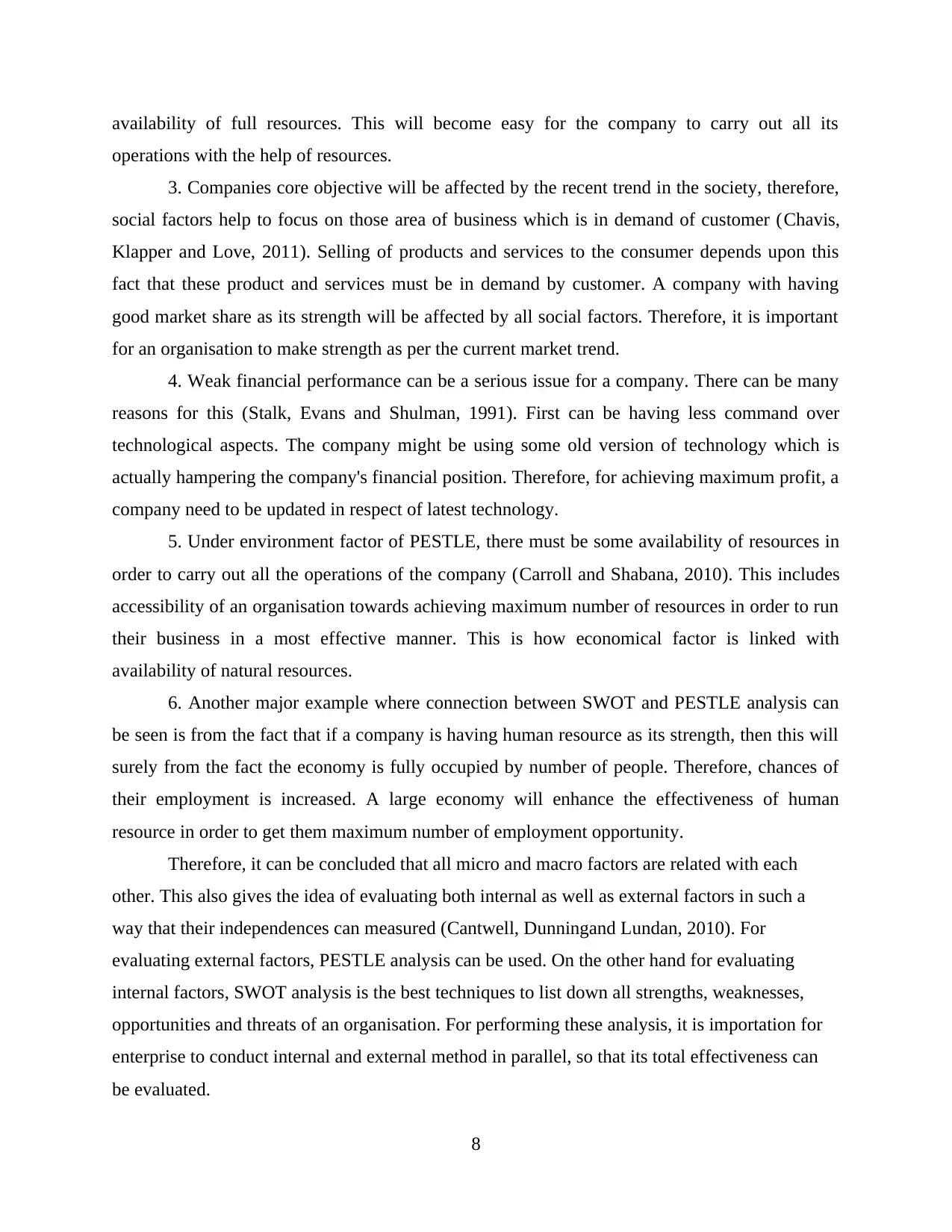
availability of full resources. This will become easy for the company to carry out all its
operations with the help of resources.
3. Companies core objective will be affected by the recent trend in the society, therefore,
social factors help to focus on those area of business which is in demand of customer (Chavis,
Klapper and Love, 2011). Selling of products and services to the consumer depends upon this
fact that these product and services must be in demand by customer. A company with having
good market share as its strength will be affected by all social factors. Therefore, it is important
for an organisation to make strength as per the current market trend.
4. Weak financial performance can be a serious issue for a company. There can be many
reasons for this (Stalk, Evans and Shulman, 1991). First can be having less command over
technological aspects. The company might be using some old version of technology which is
actually hampering the company's financial position. Therefore, for achieving maximum profit, a
company need to be updated in respect of latest technology.
5. Under environment factor of PESTLE, there must be some availability of resources in
order to carry out all the operations of the company (Carroll and Shabana, 2010). This includes
accessibility of an organisation towards achieving maximum number of resources in order to run
their business in a most effective manner. This is how economical factor is linked with
availability of natural resources.
6. Another major example where connection between SWOT and PESTLE analysis can
be seen is from the fact that if a company is having human resource as its strength, then this will
surely from the fact the economy is fully occupied by number of people. Therefore, chances of
their employment is increased. A large economy will enhance the effectiveness of human
resource in order to get them maximum number of employment opportunity.
Therefore, it can be concluded that all micro and macro factors are related with each
other. This also gives the idea of evaluating both internal as well as external factors in such a
way that their independences can measured (Cantwell, Dunningand Lundan, 2010). For
evaluating external factors, PESTLE analysis can be used. On the other hand for evaluating
internal factors, SWOT analysis is the best techniques to list down all strengths, weaknesses,
opportunities and threats of an organisation. For performing these analysis, it is importation for
enterprise to conduct internal and external method in parallel, so that its total effectiveness can
be evaluated.
8
operations with the help of resources.
3. Companies core objective will be affected by the recent trend in the society, therefore,
social factors help to focus on those area of business which is in demand of customer (Chavis,
Klapper and Love, 2011). Selling of products and services to the consumer depends upon this
fact that these product and services must be in demand by customer. A company with having
good market share as its strength will be affected by all social factors. Therefore, it is important
for an organisation to make strength as per the current market trend.
4. Weak financial performance can be a serious issue for a company. There can be many
reasons for this (Stalk, Evans and Shulman, 1991). First can be having less command over
technological aspects. The company might be using some old version of technology which is
actually hampering the company's financial position. Therefore, for achieving maximum profit, a
company need to be updated in respect of latest technology.
5. Under environment factor of PESTLE, there must be some availability of resources in
order to carry out all the operations of the company (Carroll and Shabana, 2010). This includes
accessibility of an organisation towards achieving maximum number of resources in order to run
their business in a most effective manner. This is how economical factor is linked with
availability of natural resources.
6. Another major example where connection between SWOT and PESTLE analysis can
be seen is from the fact that if a company is having human resource as its strength, then this will
surely from the fact the economy is fully occupied by number of people. Therefore, chances of
their employment is increased. A large economy will enhance the effectiveness of human
resource in order to get them maximum number of employment opportunity.
Therefore, it can be concluded that all micro and macro factors are related with each
other. This also gives the idea of evaluating both internal as well as external factors in such a
way that their independences can measured (Cantwell, Dunningand Lundan, 2010). For
evaluating external factors, PESTLE analysis can be used. On the other hand for evaluating
internal factors, SWOT analysis is the best techniques to list down all strengths, weaknesses,
opportunities and threats of an organisation. For performing these analysis, it is importation for
enterprise to conduct internal and external method in parallel, so that its total effectiveness can
be evaluated.
8
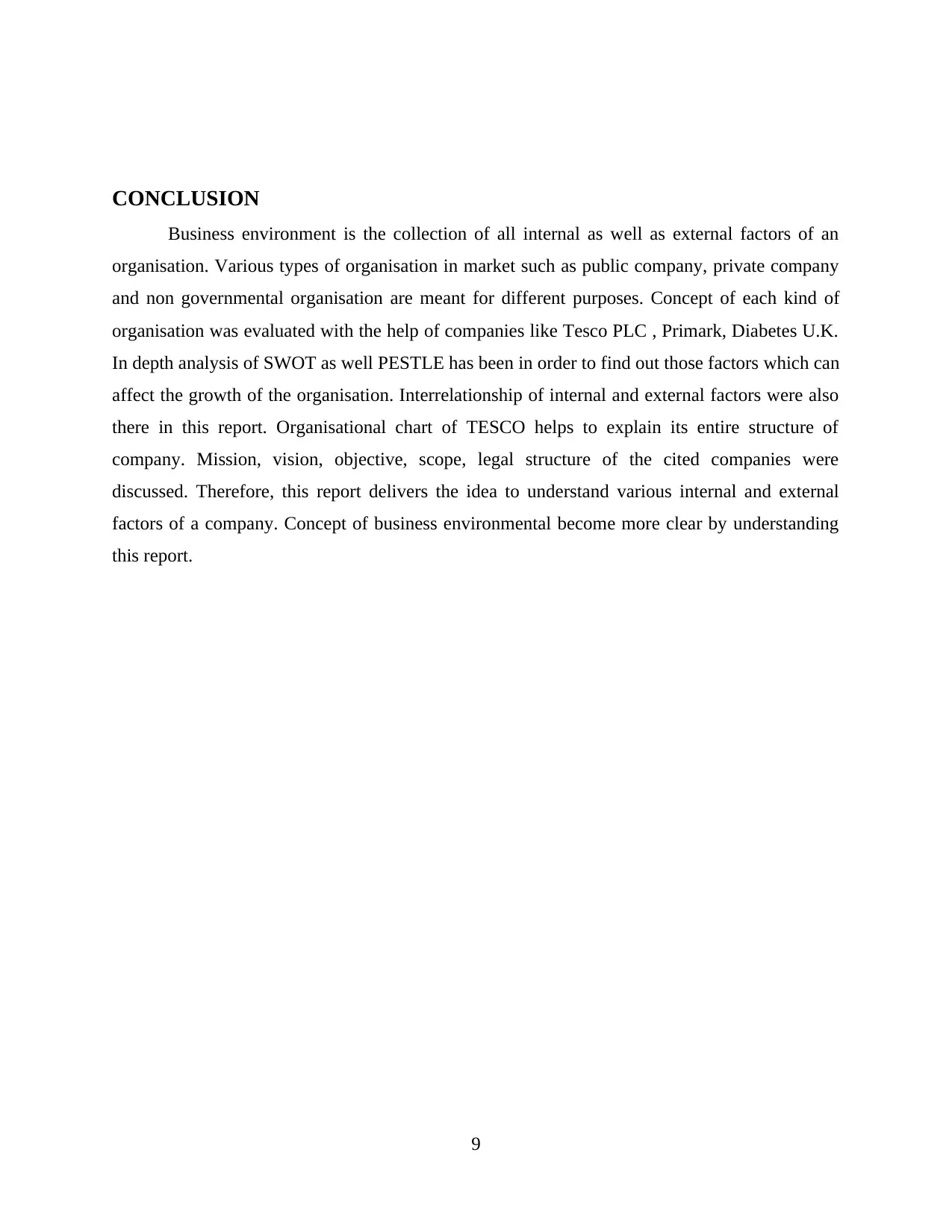
CONCLUSION
Business environment is the collection of all internal as well as external factors of an
organisation. Various types of organisation in market such as public company, private company
and non governmental organisation are meant for different purposes. Concept of each kind of
organisation was evaluated with the help of companies like Tesco PLC , Primark, Diabetes U.K.
In depth analysis of SWOT as well PESTLE has been in order to find out those factors which can
affect the growth of the organisation. Interrelationship of internal and external factors were also
there in this report. Organisational chart of TESCO helps to explain its entire structure of
company. Mission, vision, objective, scope, legal structure of the cited companies were
discussed. Therefore, this report delivers the idea to understand various internal and external
factors of a company. Concept of business environmental become more clear by understanding
this report.
9
Business environment is the collection of all internal as well as external factors of an
organisation. Various types of organisation in market such as public company, private company
and non governmental organisation are meant for different purposes. Concept of each kind of
organisation was evaluated with the help of companies like Tesco PLC , Primark, Diabetes U.K.
In depth analysis of SWOT as well PESTLE has been in order to find out those factors which can
affect the growth of the organisation. Interrelationship of internal and external factors were also
there in this report. Organisational chart of TESCO helps to explain its entire structure of
company. Mission, vision, objective, scope, legal structure of the cited companies were
discussed. Therefore, this report delivers the idea to understand various internal and external
factors of a company. Concept of business environmental become more clear by understanding
this report.
9
⊘ This is a preview!⊘
Do you want full access?
Subscribe today to unlock all pages.

Trusted by 1+ million students worldwide
1 out of 14
Related Documents
Your All-in-One AI-Powered Toolkit for Academic Success.
+13062052269
info@desklib.com
Available 24*7 on WhatsApp / Email
![[object Object]](/_next/static/media/star-bottom.7253800d.svg)
Unlock your academic potential
Copyright © 2020–2025 A2Z Services. All Rights Reserved. Developed and managed by ZUCOL.





